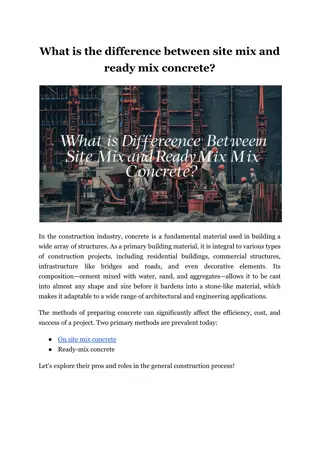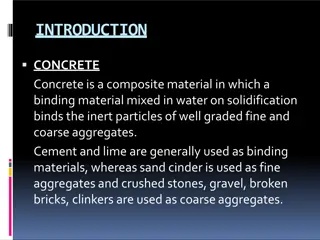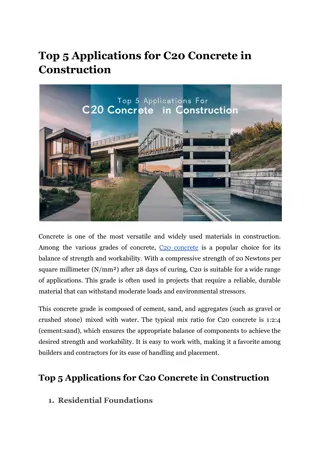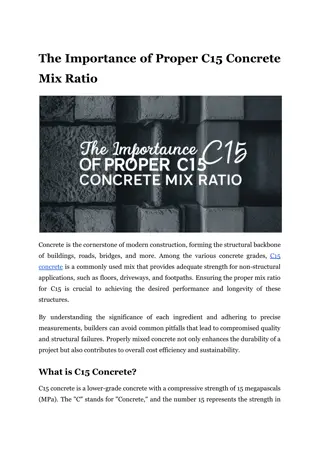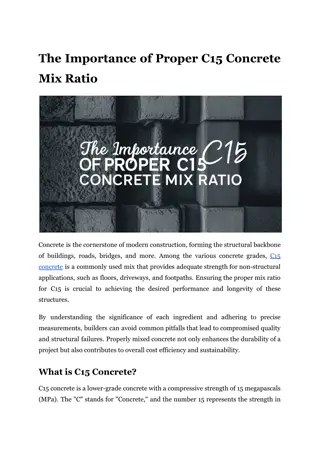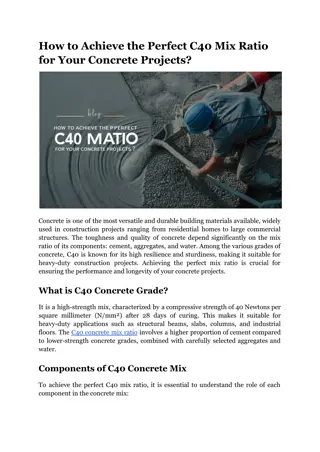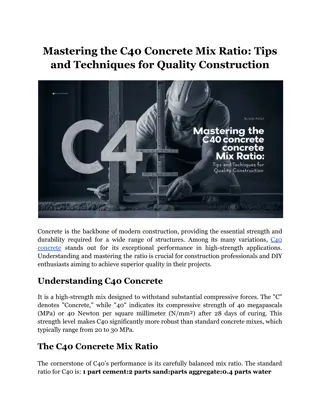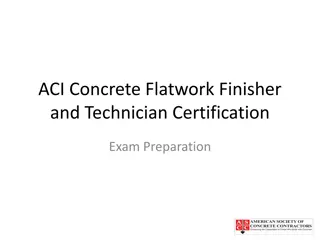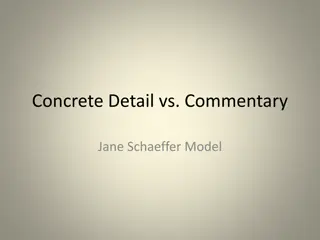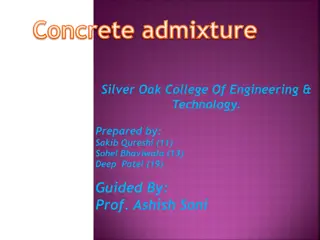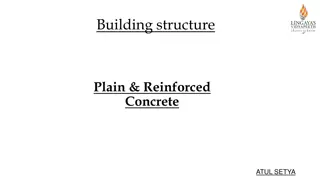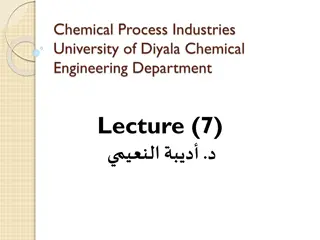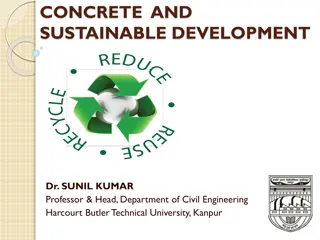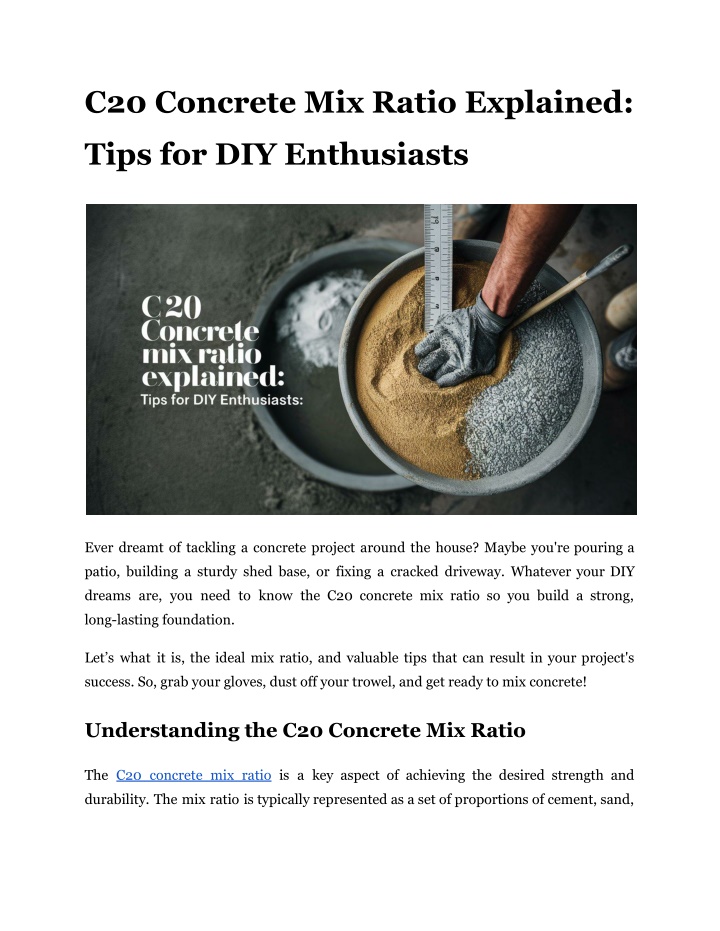
C20 Concrete Mix Ratio Explained: Tips for DIY Enthusiasts
Master the C20 concrete mix ratio with our expert tips. Perfect for DIY projects, ensure strong, durable results every time.n
Download Presentation

Please find below an Image/Link to download the presentation.
The content on the website is provided AS IS for your information and personal use only. It may not be sold, licensed, or shared on other websites without obtaining consent from the author. If you encounter any issues during the download, it is possible that the publisher has removed the file from their server.
You are allowed to download the files provided on this website for personal or commercial use, subject to the condition that they are used lawfully. All files are the property of their respective owners.
The content on the website is provided AS IS for your information and personal use only. It may not be sold, licensed, or shared on other websites without obtaining consent from the author.
E N D
Presentation Transcript
C20 Concrete Mix Ratio Explained: Tips for DIY Enthusiasts Ever dreamt of tackling a concrete project around the house? Maybe you're pouring a patio, building a sturdy shed base, or fixing a cracked driveway. Whatever your DIY dreams are, you need to know the C20 concrete mix ratio so you build a strong, long-lasting foundation. Let s what it is, the ideal mix ratio, and valuable tips that can result in your project's success. So, grab your gloves, dust off your trowel, and get ready to mix concrete! Understanding the C20 Concrete Mix Ratio The C20 concrete mix ratio is a key aspect of achieving the desired strength and durability. The mix ratio is typically represented as a set of proportions of cement, sand,
and aggregates (coarse and fine). The standard mix ratio for C20 concrete is 1:2:4, which means: 1 part cement 2 parts sand 4 parts coarse aggregate Applications of C20 Concrete C20 concrete is ideal for: Residential driveways and paths Patios and garden paving Floor slabs for garages and workshops Foundations for small buildings and structures Lightweight structural applications Components of C20 Concrete Mix To prepare a C20 concrete mix, you need to gather the following materials: 1. Cement: Portland cement is the most common type used in concrete mixes. It acts as a binder, holding the sand and aggregates together. 2. Sand: Also known as fine aggregate, sand provides bulk and workability to the mix. Use clean, well-graded sand free from impurities. 3. Coarse Aggregate: These are larger particles, usually gravel or crushed stone, that provide strength and bulk to the mix. 4. Water: Water is essential for the hydration process, which activates the cement and allows it to bind the other materials. Read More Articles: Troubleshooting Common Issues with C25 Concrete Mixes and Solutions Mixing the C20 Concrete
Here's a step-by-step guide to mixing C20 concrete: 1. Measure the Materials: Use a standard measuring container to ensure the proportions are accurate. For a small project, you can use a bucket or a wheelbarrow. 2. Mix Dry Ingredients: Combine the cement, sand, and coarse aggregate in the desired ratio (1:2:4) in a mixing tray or a concrete mixer. Mix them thoroughly until you achieve a uniform blend. 3. Add Water: Gradually add water to the dry mix while continuously stirring. The amount of water needed will vary based on the moisture content of the sand and aggregate. Aim for a workable consistency that is not too dry or too runny. 4. Mix Thoroughly: Continue mixing until you achieve a consistent, homogenous mixture. The concrete should be smooth and free from lumps. Tips for DIY Enthusiasts Plan Ahead Before you start mixing, gather all the necessary tools and materials. Prepare the work area and formwork, and consider the weather conditions, as extreme temperatures can affect the curing process. Measure Accurately Accurate measurement of the components is crucial for achieving the desired strength. Use a consistent measuring container and stick to the recommended mix ratio. Use Clean Materials The sand and aggregate should be clean and free from impurities. Contaminants can weaken the concrete and affect its strength. Avoid Overwatering
Adding too much water can weaken the concrete and cause it to crack. Gradually add water until you achieve the desired consistency, and avoid making the mix too runny. Mix Thoroughly Proper mixing is essential for uniform and strong concrete. Take your time to mix the ingredients thoroughly. There should be no dry patches or lumps left. Work Quickly Concrete starts to set quickly, so work efficiently once you've mixed it. Pour and shape the concrete as soon as possible for a smooth finish. Cure Properly Curing is the process of keeping the concrete moist to ensure proper hydration and strength development. Cover the concrete with a plastic sheet or damp cloth and keep it moist for at least 7 days. Read More Articles: Why the C30 Concrete Mix Ratio is Ideal for High-Strength Applications? Additional Considerations for Your C20 Concrete Project Subgrade preparation: The base for your concrete should be properly compacted and leveled. This prevents settling and cracking. Expansion joints: For larger projects, incorporate expansion joints to allow for natural movement and prevent cracking. When to Call in the Professionals Large or complex projects: Extensive projects like patios, driveways, or large slabs require significant concrete volume and precise techniques. Hiring a
professional concrete contractor means you get proper mix design, efficient pouring, and a level, crack-free finish. Specialised concrete needs: Some projects might require specific concrete types like stamped concrete or high-performance mixes. Experienced contractors have the expertise and equipment to handle these specialty applications. Time constraints: If you're short on time, hiring a concrete contractor can significantly expedite the project. Their experience allows them to complete the job efficiently, minimising disruption to your daily life. The Final Touches For larger or more complex projects, remember there's no shame in seeking professional help. A qualified concrete contractor guarantees flawless execution, saving you time, effort, and potential headaches. For those seeking a seamless and professional concrete solution, Pro-Mix Concrete is here to help! The team possesses the expertise and equipment to handle any concrete project, big or small. Contact us today for a free consultation and quote. Site Article: C20 Concrete Mix Ratio Explained: Tips for DIY Enthusiasts

